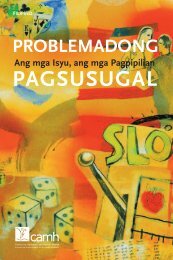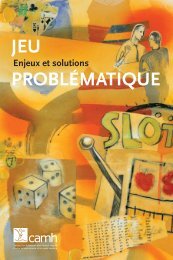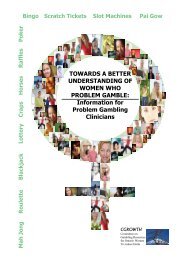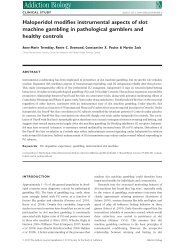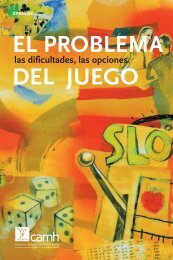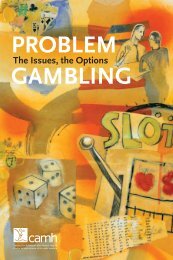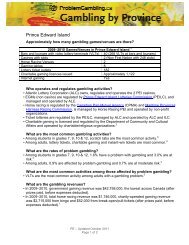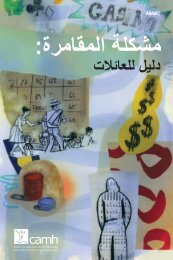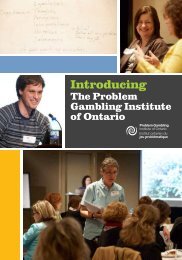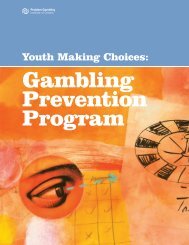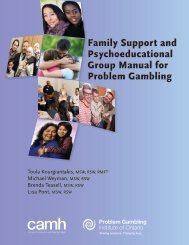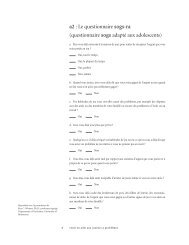Probability, Random Events, and the Mathematics of Gambling
Probability, Random Events, and the Mathematics of Gambling
Probability, Random Events, and the Mathematics of Gambling
You also want an ePaper? Increase the reach of your titles
YUMPU automatically turns print PDFs into web optimized ePapers that Google loves.
about events that are equally likely. For example, <strong>the</strong> bar symbol on a slot machine might<br />
have a probability <strong>of</strong> 25%, while a double diamond might have a probability <strong>of</strong> 2%. This does<br />
not actually contradict <strong>the</strong> idea <strong>of</strong> equally likely outcomes. Instead, think <strong>of</strong> <strong>the</strong> 25% as 25<br />
chances <strong>and</strong> <strong>the</strong> 2% as two chances, for a total <strong>of</strong> 27 chances out <strong>of</strong> 100. Each <strong>of</strong> those 27<br />
chances is equally likely. As ano<strong>the</strong>r example, in rolling two dice <strong>the</strong>re are 36 possible<br />
outcomes: (1, 1), (1, 2), (1, 3), (1, 4), (1, 5), (1, 6), (2, 1) . . . (6, 6); <strong>and</strong> each <strong>of</strong> <strong>the</strong>se<br />
combinations is equally likely to happen. A player rolling 2 dice, however, is most likely to<br />
get a total <strong>of</strong> 7 because <strong>the</strong>re are six ways to make a 7 from <strong>the</strong> two dice: (1, 6), (2, 5), (3, 4),<br />
(4, 3), (5, 2) <strong>and</strong> (6, 1). A player is least likely to get a total <strong>of</strong> ei<strong>the</strong>r 2 or 12 because <strong>the</strong>re is<br />
only one way to make a 2 (1, 1) <strong>and</strong> one way to make a 12 (6, 6).<br />
Independence <strong>of</strong> <strong>Events</strong><br />
A basic assumption in probability <strong>the</strong>ory is that each event is independent <strong>of</strong> all o<strong>the</strong>r events.<br />
That is, previous draws have no influence on <strong>the</strong> next draw. A popular catch phrase is “<strong>the</strong><br />
dice have no memory.” A die or roulette ball cannot look back <strong>and</strong> determine that it is due for<br />
a 6 or some o<strong>the</strong>r number. How could a coin decide to turn up a head after 20 tails? Each<br />
event is independent <strong>and</strong> <strong>the</strong>refore <strong>the</strong> player can never predict what will come up next. If a<br />
fair coin was flipped 5 times <strong>and</strong> came up heads 5 times in a row, <strong>the</strong> next flip could be ei<strong>the</strong>r<br />
heads or tails. The fact that heads have come up 5 times in a row has no influence on <strong>the</strong> next<br />
flip. It is wise not to treat something that is very very unlikely as if it were impossible (see<br />
Turner, 1998, <strong>and</strong> “Incremental Betting Strategies” in Part 1.5, “Games <strong>and</strong> Systems”). In<br />
fact, if a coin is truly r<strong>and</strong>om, it must be possible for heads to come up 1 million times in a<br />
row. Such an event is extraordinarily unlikely, p = 1/2 1,000,000 , but possible. Even <strong>the</strong>n, <strong>the</strong><br />
next flip is just as likely to be heads as it is tails. None<strong>the</strong>less, many people believe that a coin<br />
corrects itself; if heads comes up too <strong>of</strong>ten, <strong>the</strong>y think tails is due.<br />
To complicate matters, however, <strong>the</strong>re are cases where r<strong>and</strong>om events are not completely<br />
independent. With cards, <strong>the</strong> makeup <strong>of</strong> <strong>the</strong> deck is altered as cards are drawn from <strong>the</strong> deck.<br />
As a result, <strong>the</strong> value <strong>of</strong> subsequent cards is constrained by what has already been drawn.<br />
None<strong>the</strong>less, each <strong>of</strong> <strong>the</strong> cards that remains in <strong>the</strong> deck is still equally probable. If, for<br />
example, <strong>the</strong>re are only six cards left in a deck, four 7s <strong>and</strong> two 8s, a 7 is twice as likely to be<br />
drawn as an 8, but <strong>the</strong> specific card, <strong>the</strong> 7 <strong>of</strong> spades, has <strong>the</strong> same probability <strong>of</strong> being drawn<br />
as <strong>the</strong> 8 <strong>of</strong> diamonds.<br />
Opportunities Abound<br />
Ano<strong>the</strong>r key aspect to computing probability is factoring in <strong>the</strong> number <strong>of</strong> opportunities for<br />
something to occur. The more opportunities <strong>the</strong>re are, <strong>the</strong> more likely it is that an event will<br />
occur. The more tickets a player buys or <strong>the</strong> more <strong>of</strong>ten a player buys <strong>the</strong>m, <strong>the</strong> greater <strong>the</strong><br />
7




